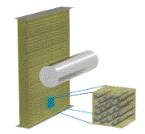Mechanical and Materials Engineering, Department of

Department of Engineering Mechanics: Dissertations, Theses, and Student Research
Date of this Version
8-2012
Document Type
Thesis
Abstract
Recently a shift in the focus of permanent magnetic research has moved from Rare Earth (RE)-based alloys to those made from more readily available elements. Because of their relatively large magnetocrystalline anisotropy, L10 compounds have the potential for use as permanent magnet materials. One particular alloy that is readily available and inexpensive is near equi-atomic manganese and aluminum (Mn50-Al50). First characterized in 1958, it did not receive much attention until more recently when RE supply chain issues made the alloy more attractive for commercial and research applications. The ferromagnetic (FM) τ-phase (L10) is metastable and formed from a parent, high-temperature ε-phase (A3). The ε-phase can be retained at room temperature by rapid quenching, and subsequent annealing transforms it to the τ-phase. For this reason the stability of both phases has been explored and the addition of carbon has been noted to improve stability.
This study explores a number of alloying and processing schemes designed to improve the magnetic properties. These include the effect of boron additions, and novel mechanical milling techniques. Manganese-aluminum permanent magnets were synthesized by arc-melting and subsequent melt-spinning with different alloy compositions. The magnetic properties, X-ray diffraction patterns, and the phase transformation kinetics were analyzed. Boron is found to have little to no effect on the formation of the FM τ-phase (L10) or its parent ε- phase (A3) and in fact reduces the stability of the metastable phases in favor of the equilibrium phases (βMn (A13) and γ2 (D810)), resulting in an overall deleterious effect on magnetic performance. Post-processing techniques such as High Energy Ball Milling (HEBM) and Surfactant Assisted Mechanical Milling (SAMM) were determined to increase the coercivities of the alloys. Maximum coercivities (Hc) of 3.88 kOe and 4.22 kOe were observed for the HEBM samples and SAMM samples, respectively. Furthermore a maximum saturation magnetization (Ms) of 134 emu/g was measured for a ternary alloy of Mn54Al44C2 which is the highest reported.
Adviser: Jeffrey E. Shield
Included in
Mechanical Engineering Commons, Metallurgy Commons, Other Materials Science and Engineering Commons


Comments
A thesis Presented to the Faculty of The Graduate College at the University of Nebraska In Partial Fulfillment of Requirements For the Degree of Master of Science, Major: Engineering Mechanics, Under the Supervision of Professor Jeffrey E. Shield. Lincoln, Nebraska: August, 2012
Copyright (c) 2012 Timothy E. Prost